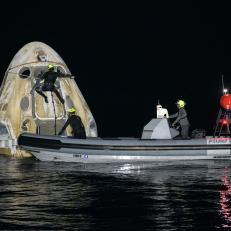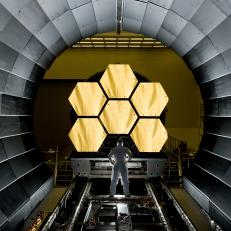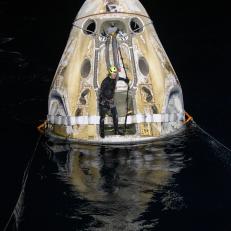Looking Back at 2020 in Space
From historic launches to the Artemis Program, 2020 has been a busy year in space exploration. Let’s take a look back at some of the key moments!
NASA and SpaceX Demo-2 Launch
A SpaceX Falcon 9 rocket carrying the company’s Crew Dragon spacecraft is launched from Launch Complex 39A on NASA’s SpaceX Demo-2 mission to the International Space Station with NASA astronauts Robert Behnken and Douglas Hurley onboard, Saturday, May 30, 2020, at NASA’s Kennedy Space Center in Florida. The historic launch marked the beginning of the commercial crew era of U.S. human spaceflight from American soil.
NASA Astronauts Robert Behnken and Douglas Hurley
NASA Astronauts Bob Behnken and Doug Hurley were the first crew to fly in SpaceX's Crew Dragon capsule. Demo-2 was a successful test mission. Bob and Doug completed roughly a 2-month stay aboard the International Space Station.
SpaceX Demo-2 Splashdown
The SpaceX Crew Dragon Endeavour spacecraft is seen as it lands with NASA astronauts Robert Behnken and Douglas Hurley onboard in the Gulf of Mexico off the coast of Pensacola, Florida, Sunday, August 2, 2020. The Demo-2 test flight for NASA's Commercial Crew Program was the first to deliver astronauts to the International Space Station and return them safely to Earth onboard a commercially built and operated spacecraft. Behnken and Hurley returned after spending 64 days in space.
NASA's Perseverance Mars Rover
The Mars 2020 Perseverance Rover launched on July 30, 2020, from Cape Canaveral Air Force Station, Florida. It is scheduled to land February 18, 2021, at the Jezero Crater on Mars. Perseverance's mission is to seek signs of ancient life, and collect rock, as well as soil samples for possible return to Earth.
NASA's Ingenuity Mars Helicopter
The Mars Helicopter launched strapped to the belly of the Mars Rover on July 30, 2020, from Cape Canaveral Air Force Station, Florida. It is scheduled to land February 18, 2021, at the Jezero Crater on Mars. Ingenuity is the first aircraft to attempt flight on the Red Planet. It has the same goal as Perseverance, to find any signs of habitable life on Mars.
SpaceX's Starlink
Starlink is a growing network of satellites capable of providing a subscription based high-speed internet service across the globe. This includes many remote areas of planet Earth. As of this year, over 800 Starlink Satellites are currently in orbit with more to follow in 2021. SpaceX is expecting to have around 42,000 in lower Earth orbit when complete creating a “mega-constellation” train in the night sky.
Expedition 64
Three members of Expedition 64, NASA astronaut Kate Rubins, Roscosmos cosmonaut Sergey Ryzhikov, and Roscosmos cosmonaut Sergey Kud-Sverchkov launched to the International Space Station on October 14, 2020, aboard a Soyuz MS-17 spacecraft from the Baikonur Cosmodrome in Kazakhstan. They were welcomed by the crew of Expedition 63 who later returned home. They have since been joined by NASA astronauts Mike Hopkins, Victor Glover, Shannon Walker, and Japan Aerospace Exploration Agency astronaut Soichi Noguchi of Crew-1, bringing the total of Expedition 64 crew members to seven aboard the ISS.
Expedition 63
After 196 days in space aboard the International Space Station, NASA astronaut Chris Cassidy, Roscosmos cosmonaut Anatoli Ivanishin, and Roscosmos cosmonaut Ivan Vagner returned to Earth via a parachute assisted landing on October 21, 2020. Cassidy, Ivanishin, and Vagner, orbited the Earth 3,136 times together. The Expedition 63 crew had briefly become a group of five space explorers for two months aboard the ISS as they had welcomed NASA astronauts Robert Behnken and Douglas Hurley of NASA’s SpaceX Demo-2 mission.
NASA and SpaceX Crew-1 Launch
A SpaceX Falcon 9 rocket carrying the company's Crew Dragon spacecraft launched NASA’s SpaceX Crew-1 mission to the International Space Station with NASA astronauts Mike Hopkins, Victor Glover, Shannon Walker, and Japan Aerospace Exploration Agency astronaut Soichi Noguchi onboard on Sunday, November 15, 2020, at NASA’s Kennedy Space Center in Florida. NASA’s SpaceX Crew-1 mission is the first crew rotation mission of the SpaceX Crew Dragon spacecraft to the International Space Station as part of the agency’s Commercial Crew Program.
Crew-1 Astronauts
From left are mission specialist Shannon Walker, pilot Victor Glover, and Crew Dragon commander Michael Hopkins, all NASA astronauts, and mission specialist Soichi Noguchi, Japan Aerospace Exploration Agency (JAXA) astronaut. NASA’s SpaceX Crew-1 mission is the first crew rotational flight of a U.S. commercial spacecraft with astronauts to the International Space Station. The Crew-1 mission launched to the ISS for a six-month stay.
SpaceX's Starship Prototype
Elon Musk’s SpaceX is developing a reusable transportation system for spaceflight. Starship, accompanied with a Super Heavy rocket, is a type of reusable transportation that is designed to carry passengers and cargo to the Moon and Mars. This commercial vehicle is key to establishing a human city on Mars. When paired with the Super Heavy booster, Starship stands at about 400 feet tall. Each prototype, the latest this year being SN8, goes through rounds of tests. These test launches occur at SpaceX’s site in Boca Chica, Texas.
NASA's Artemis Team
NASA chose the top nine women and men astronauts on December 9, 2020, from its active astronaut corps to form the Artemis Team, paving the way for astronaut missions on and around the Moon as part of the Artemis program. The agency is looking to land the first woman and next man on the Moon by 2024.
NASA's Artemis Program: SLS and Orion
This year, NASA stacked the first piece of the Space Launch System (SLS) rocket on the mobile launcher in preparation for the Artemis I launch next year. Artemis I will be an uncrewed flight to test the SLS rocket and Orion spacecraft as an integrated system ahead of crewed flights to the Moon with the Artemis program.
NASA's Artemis Program: HLS
NASA selected three U.S. companies this year; Blue Origin, Dynetics, and SpaceX, to design and develop human landing systems (HLS) for the agency’s Artemis program, one of which will land the first woman and next man on the surface of the Moon by 2024.
























